Following @suesa's call for entries that scientifically cover a misconception, I'm going to write about an amusing and slippery misconception that I stumble upon from time to time. I will use a minimum of anatomical terminology to keep it simple, yet still provide a sense of the relationships between different anatomical structures. The anatomic depictions might not be suited for sensitive individuals!
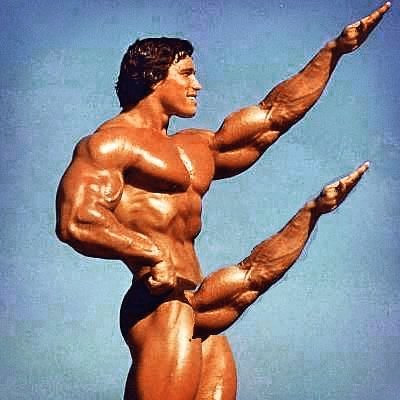
Arnold Schwarzenegger's heavy, extended arm(s)
Disclaimer: This post is not to be considered medical advice. The author of this post is neither qualified nor intending to influence your personal health decisions. Any information provided here does not claim accuracy. For any doubt about your penile health consult your health practitioner.
“Is the penis a muscle? If it is, then you can train it to make it bigger!”, or in a similar fashion naive aspirants for a lewder sex life often ruminate.
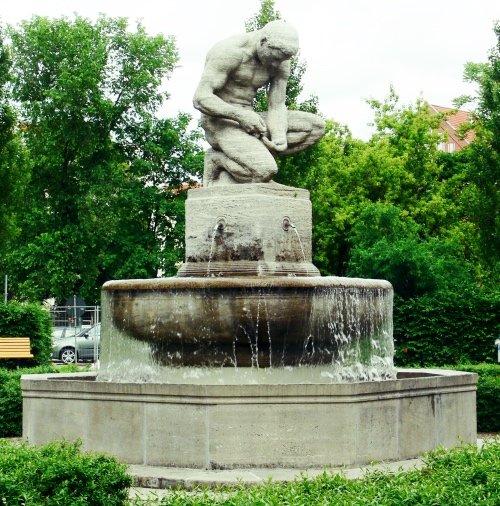
Humans have been pondering this question for quite a while already. Photo: Andreas Praefcke
To dissect the elusive muscular secrets of the masculine phallus this post will cover:
- Definitions
- Anatomy
- Physiology and Pharmacology
Definitions
To pry out of the way the semantic confusions that might arise from the statement “the penis is a muscle”, let's first look at how “penis” and “muscle” are defined by e.g. Merriam-Webster's:
“Definition of penis [...]
: a male erectile organ of copulation by which urine and semen are discharged from the body and that develops from the same embryonic mass of tissue as the clitoris.” source
“Definition of muscle
1a: a body tissue consisting of long cells that contract when stimulated and produce motion
b: an organ that is essentially a mass of muscle tissue attached at either end to a fixed point and that by contracting moves or checks the movement of a body part.” source
An example for a muscle is the Musculus biceps brachii, commonly known as just “the biceps”.
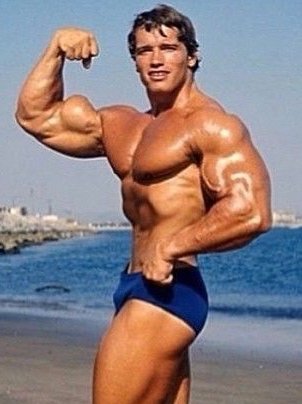
Arnold Schwarzenegger displaying his unmistakable biceps peak.
The biceps originates with its two heads from the scapula and inserts into the forearm. Its functions are to flex the elbow and the shoulder as well as to supinate the forearm.
The penis is, upon common sense examination, neither producing motion by itself nor is it attached at both of its ends to a fixed point, with the distal (away from the body) end hanging freely. Its functions as part of the male reproductive and urogenital system are to transport urine and upon erection to transport and deliver germ cells to the female counterpart of the reproductive apparatus.
Yes, the penis can grow and shrink and this is not to say that muscle tissue is not involved! But to say that the penis is a muscle constitutes the same logical trap as is saying that the Earth is a continent or that the heart is a blood vessel. By a similar logic you could also call the lung a muscle which most would agree it is not.
To relieve some of the ensuing confusion we first have to take a deeper look into muscle tissue. Muscle tissue can be subdivided into three different types that differ in their microscopic appearance, their molecular build-up and function, and the ability to be voluntarily controlled:
- Striated (skeletal) muscle
- Cardiac muscle (only to be found in the heart)
- Smooth muscle
Both skeletal and cardiac muscles appear striated under the light microscope reflecting the regular pattern of the functional units of the contractile apparatus. Skeletal muscle is under the control of the somatic (voluntary) nervous system, i.e. you can control most of your skeletal muscles voluntarily, sometimes only as part of an ingrained movement (with swallowing and singing probably being some of the most complex and fine-tuned tasks). An exception from the voluntary control are the tiny muscles around the auditory ossicles.
Smooth muscle cells can be found all over the body: around large and small vessels, around the bronchii and in the linings of internal organs where they generate peristaltic movement. Their contractile apparatus is not visible under the light microscope and has a unique molecular build-up. The length difference between relaxed and contracted states is much larger than in skeletal muscle. The contractions are slower, but can persist for much longer constituting vascular and organ tonus. Smooth muscle tissue is under the control of the vegetative (autonomous) nervous system, i.e. cannot be voluntarily controlled.
Let's continue with the interesting part: the anatomy of the penis!
The penis consists of three soft tissue bulbs: one unpaired, called corpus spongiosum (CS), and two symmetrical, paired ones, called corpora cavernosa (CC). The corpus spongiosum in isolation looks like a curved stalk, with a thick root and the bulging glans at its tip. It is attached to the median seam of the lower aspect of the perineal membrane which is basically a sheet of tissue consisting of muscles and thick connective tissue fibers that form a kind of stable demarcation between internal structures and the sensitive male parts. The bulb of CS is, furthermore, suspended and stabilized by ligaments emerging from the hipbone.
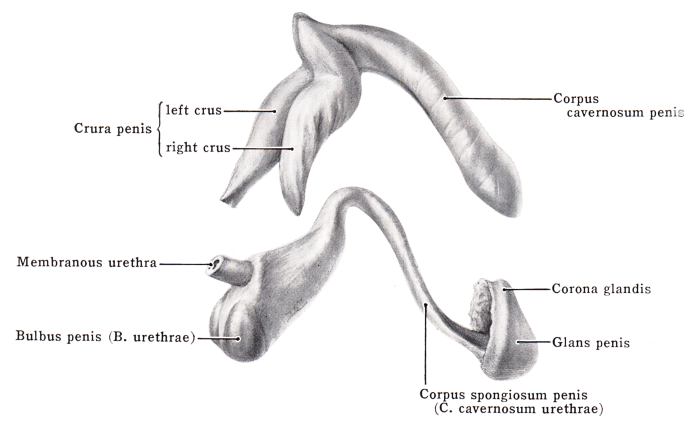
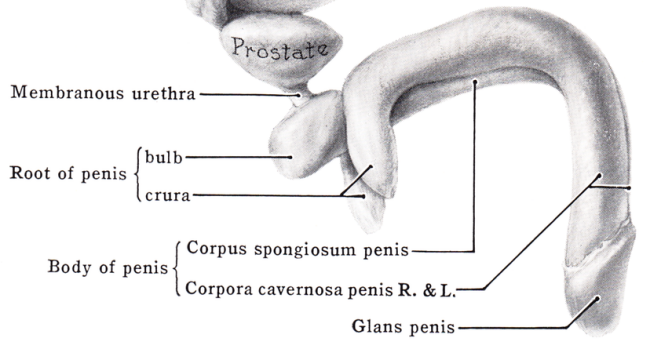
Top panel: CS and CC dissociated from each other. Bottom panel: CS and CC in their natural position relative to each other and the prostate. By Grant, John Charles Boileau - An atlas of anatomy / by regions 1962.
The two corpora cavernosa are attached bilaterally to the lower ridge of the ischiopubic hipbone (this is the one that contributes to the bony border of the “O-shaped” opening). They run separately until they conjoin at the exit to the exterior of the body, underneath the pubic bone, and from there form the mighty bipartite shape of the visible penis body. They lie on top of the CS and fuse bluntly into the pit of the glans. They are what can be seen when looking down onto the precious member. For the male or extra exploratory female readers: try to touch and trace the corpora underneath the testicles to their origin just in front of the anus. (I assume that you are very familiar with their position on the exterior of the body). It is the easiest when done with a concurring erection.
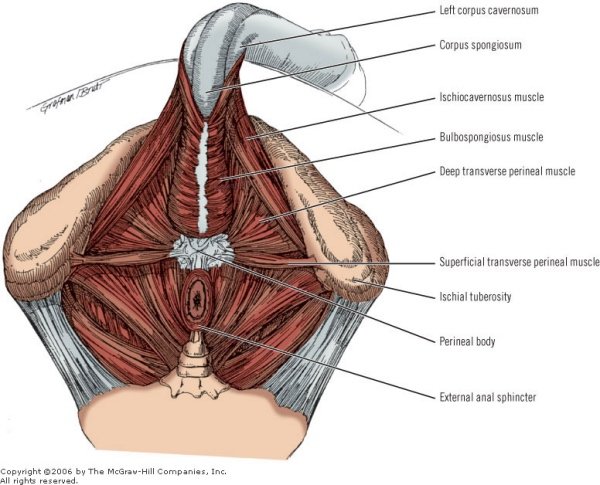
Depiction of the origin of the penile corpora partly covered by their attached muscles. Skin, subcutaneous tissue and testicles are removed. View from the bottom.
The CS, at its root, is lined by a striated muscle called Musculus bulbospongiosus (M. bs), which originates at the perineal seam and inserts onto the bottom surface of CS. The CC are supported, on the right and left side, by the Musculus ischiocavernosus (M. ic), which parallels the CC by originating from the ischiopubic bone and inserts onto the crura of the CC.
Upon contraction, the M. bs and M. ic function in emptying the urethra, in supporting the upholding of an erection and in the pulsatory contractions associated with ejaculation. They are innervated by the somatic nerve called Nervus pudendus, and thus can be willingly controlled allowing for a movement of the penis, albeit in a limited range of motion. To see what it looks like when these muscles are willingly flexed, check out this NSFW video.
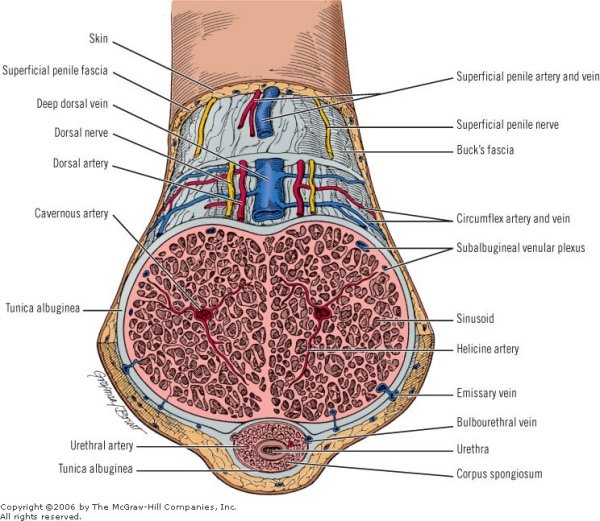
Cross section through the penis at its exterior part highlighting the blood supply and the trabecular web in the inner of the corpora.
The CC and CS themselves are made of spongy tissues cointaining a network of trabecules that consist of connective tissue fibers and smooth muscle cells (SMCs). The deep artery of the penis provides the blood flow and its branches flow into the trabecular caverns. During an erection the caverns get flooded with blood which makes the penis swell. At the same time the veins on the outer layers around the corpora get compressed and the blood flow back to the heart is constricted, keeping the blood within the penis and sustaining the erection.
How does an erection happen? Let's finally cover the physiology and pharmacology of our topic.
Normally, the SMCs in the corpora of the penis are contracted and keep the arteries shut and the trabecules narrow in space. The penis is flaccid. Upon sexual arousal the parasympathicus (the pillar of the vegetative system that provides recovery and relaxation) sends signals to the nerve endings on the penis to synthesize the signal transmitter Nitric oxide (NO, a gaseous molecule). NO diffuses to the SMCs around the arteries including their branches and the SMCs of the trabecules. Inside the cells, NO binds and activates the enzyme guanylyl cyclase which in turn synthesizes the secondary messenger cGMP. cGMP, by two further molecular mechanisms, then leads to the relaxation of the contractile fibers within the SMCs. This allows the arteries to dilate, the trabecules to stretch, and hence the corpora to get filled and the penis to throbbingly grow with a blood pressure of up to 1200 mmHg (ten times the normal blood pressure)!
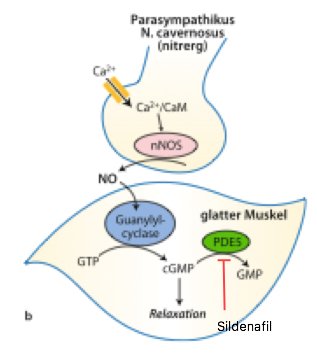
The molecular mechanism of smooth muscle relaxation in the penis. The inhibitory mode of action of Sildenfail (Viagra) is shown with a red, blunted arrow.
The infamoul pill that made Pfizer rich(er) - Sildenafil (better known under its brand name Viagra) - acts by inhibiting the enzyme Phosphodiesterase 5 (PDE5). PDE5 usually degrades cGMP. When PDE5 is inhibited by Viagra and sexual arousal is present, the cGMP concentrations rise much more quickly and sustainably since PDE5 is inactive. Thus, the erection is stronger and more persistent.
To make a turn back to muscles: Supplements that promote the formation of NO are advertised and sold to enhance exercise performance. They accomplish this by promoting the relaxation of the smooth muscles layers around the arteries leading to their dilation. This improves the blood flow to the muscles, thus providing oxygen and nutrients.
So, is the penis a muscle? I hope I could convince you that it is not! It is an organ that consists of three bulbs of spongy tissue that have the propensity to get rigid as a consequence of blood retention within their inner spaces. Striated muscles support the penis structurally and functionally while smooth muscle tissue is important for the switch between flaccid and erected states of the penis, by constricting or allowing blood flow, respectively.
Notably, the smooth muscles cells of the penis exert their reproductive task by relaxing, and not by contracting as do the biceps or the abdominals when they attract the female sex.
If you still hold on to the belief that the penis is a muscle, please don't try to exercise it the same way that you do your muscles, otherwise you might end up like this guy.
I would also caution against methods that apply stretching and promise to enlarge the penis by allegedly making the smooth muscles cells grow as advertised on this, admittingly, informative site. It isn't clear to me how more of these cells is going to make it larger. Stretching, in contrast, might harm this sensitive tissue and lead to erectile dysfunction.
I hope you enjoyed this post and don't have to spend any more time on pondering the debated question!
Yours, @replichara
Abbreviations:
- CS - Corpus spongiosum
- CC - Corpus cavernosum
- M. bs - Musculus bulbospongiosum
- M. ic - Musculus ischiocavernosum
- SMCs - Smooth muscle cells
- PDE5 - Phosphodiesterase 5
Picture sources, in the order of their appearance:
8 - M. Freissmuth, S. Offermanns, S. Böhm. Pharmakologie & Toxikologie. Springer Medizin Verlag Heidelberg 2012. Page 402.
Knowledge sources:
R. Lüllmann-Rauch. Taschenlehrbuch Histologie. 2e Auflage 2006. Georg Thieme Verlag AG, Stuttgart.
https://en.wikipedia.org/wiki/Biceps
https://www.mananatomy.com/body-systems/muscular-system/bulbospongiosus-muscle
https://www.mananatomy.com/body-systems/muscular-system/ischiocavernosus-muscle
https://www.ncbi.nlm.nih.gov/pubmed/21395365
